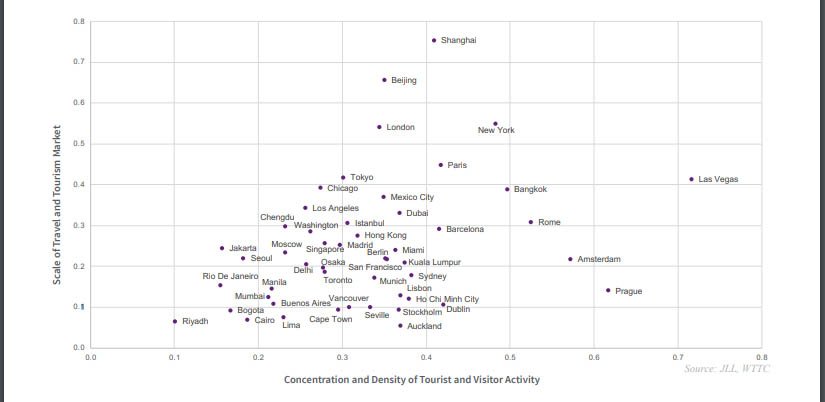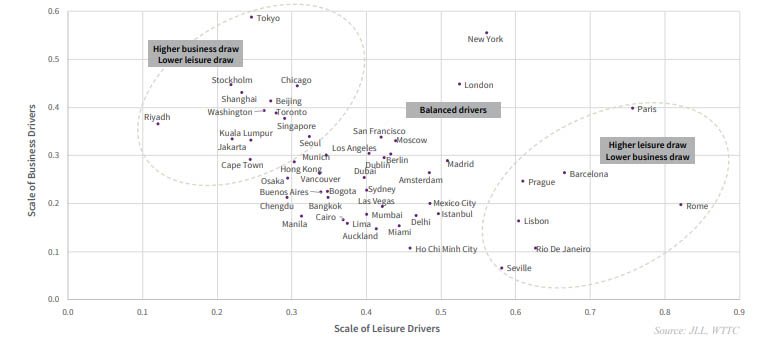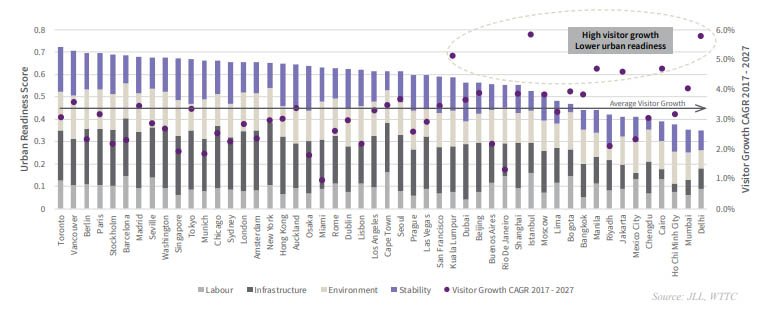Compiled by Satyaki Dutta
The World Travel & Tourism Council (WTTC), in collaboration with the commercial real estate firm JLL, undertook a study to research the global cities’ state and preparation level to accommodate travel and tourism growth in the upcoming decade.
The study, known as Destination 2030, took into consideration 50 cities, probing the points and specs with more than 75 indicators, to see what makes an urban hub ready for travel and tourism growth including the things like the urban infrastructure, tourism assets and city-level policies as their implementations.
The basic approach was to assess the ‘readiness’ of the city according to these factors. This has the potential to help city governments and tourism bodies better understand the position of the cities for future growth while learning about other cities’ best practices and identifying gaps and the opportunities for future tourism strategy planning.

Figure: Framework of city readiness for tourism growth
The report clearly establishes that travel and tourism is an essential industry in the world economy with the contribution of 10.4 percent to global GDP. It was also responsible for the creation of one in five new jobs over the last five years. WTTC has a history of 25 years of research to quantify the economic impact of the sector in 185 countries.
In the present time, over 55 percent of world’s population lives in urban zones and expected to rise to 68 percent by 2050. China, India and Nigeria are expected to account for 35 percent of projected growth. Forecasts show that urbanisation combined with population growth could add another 2.5 billion people to urban areas by 2050. Thus, cities and city tourism drive both country and sector growth on a significant scale.
According to this study, an index was created which brings together a broad spectrum of destination practices and community attributes to determine a level and type of readiness. Varying levels of infrastructure in the established market tourism hubs help to define the level of readiness, based on which, five city typologies were defined.

Dawning Developers: The new kids in the block, which have a slow growth rate in the tourism sector and lower visitor rate in the present time. The list includes Bogota, Buenos Aires, Lima, Manila, Moscow, Rio de Janeiro, Mumbai, Cairo, Kuala Lumpur and Riyadh.
Emerging Performers: The cities with growing momentum and increased pressures in the tourism sector. Some of the emerging performers are Bangkok, Cape Town, New Delhi, Ho Chi Minh City and Mexico City.
Balanced Dynamics: This category makes up financial hubs, which tend to have lower leisure travel rate and room for growth without straining infrastructure. The present list includes Beijing, Dubai, Chicago, Hong Kong; Munich, Shanghai, Singapore, Tokyo.

Figure: Travel and tourism scale vs. Concentration
Mature Performers: These cities combine strong leisure and/or business travel. The well-known cities are Berlin, Dublin, Las Vegas, London; Los Angeles, Lisbon.

Figure: Scale of Leisure vs Business Drivers
Managing Momentum: The final category is those destinations where there is high growth of momentum driven by leisure travel and business travel combination. This category has the cities which are struggling with overtourism including Barcelona, Amsterdam, Prague, Rome, Paris.

Figure: Overall urban readiness for tourism growth
Hence, the study makes up the complete overview of various cities and their probability of tourism growth in the upcoming decade.


